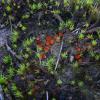
21-11-2025 11:52
Jean-Luc RangerBonjour à tous, on voit toujours 2 espèces areni

21-11-2025 10:56
 Christopher Engelhardt
Christopher Engelhardt
Very small (~0,5 mm) white ascos, found yesterday

14-11-2025 16:26
 Marian Jagers
Marian Jagers
Hello everyone, On dead wood of Cytisus scoparius

17-11-2025 21:46
Philippe PELLICIERBonjour,Récolté sur bois pourrissant de feuillu

20-11-2025 14:14
Mick PeerdemanFound on the leaves of 'Juglans regia' in the Neth

20-11-2025 13:07
Mick PeerdemanIn January i found these black markings on the dea

:-)
When making micropics, make sure to use Cotton Blue preparation, especially with mature ascospores. The apothecium whose sections readily ejected spores when observed in tap water with no pressure applied should be used for subsequent CB preparation so that you can be sure you are dealing with completely developed spores. It is critical for identification of an Scutellinia species. When making CB prep. make sure you also include finely sectioned margin. The contrasted marginal hairs would reveal also the structure of their bases - also crucial for identifying the species!
I will also send you an e-mail soon regarding our older issue!
Cheers,
Neven

Is it found in Netherlands ? Near sea ?
After your first microscopic research, is it possible to ask you a part of your collection ?
We'll look forward your microphotos.
Read you soon,
Beñat
Unfortunally i do not have CB yet, hopefully thursday. But i made micropictures anyway. The ascus is 275 long. SPores seem to be larger then mentioned, 22.5 * 12.5. The hairsbase is bifurcate
ps Neven i loke forward to youre mail!

It's difficult to say anything just with this. Scutellinia is a difficult genus. It is important to have :
- sporal ornementation (in CB, like Neven said)
- hairs measures
- hairs base (here, we can see bifurcate but are you sure that all have bifurcated bases ?)
Your spores measurements can't help us because 20-22 x 12 are the most common measures in this genus...
Read you later,
Beñat







